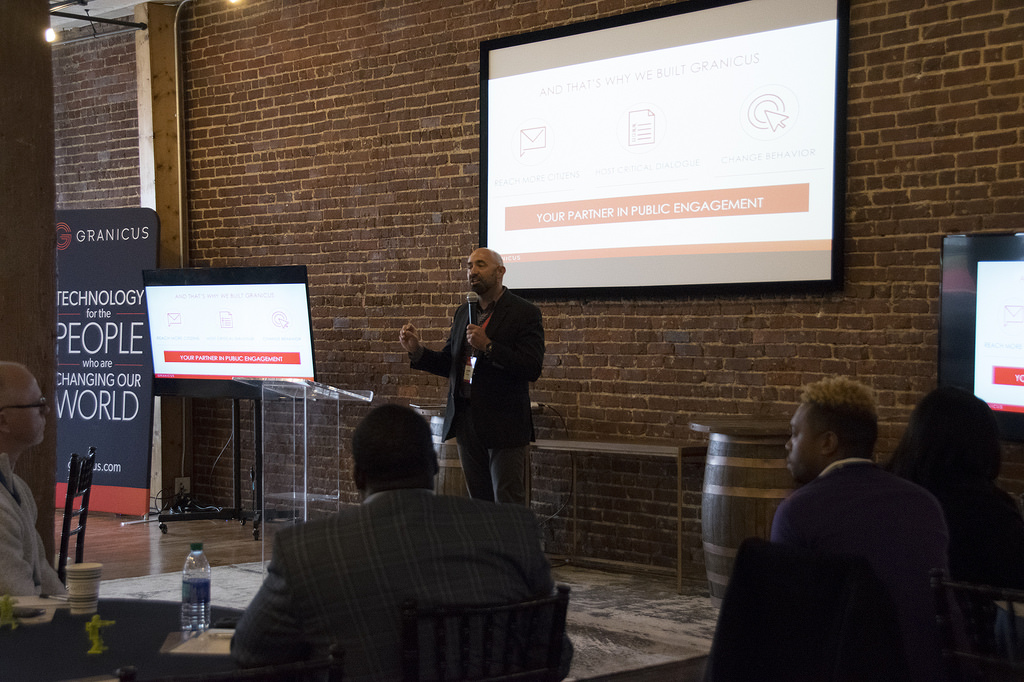
Citizen engagement is critical for a healthy society. But the reality is that across the country, just 6 percent of the population takes part in civic service, with only 8 percent of adults participating in neighborhood issues. Statistically speaking, that means 9.6 million Georgians are not engaging with government. Granicus hosted a free training in Atlanta on March 21 to discuss strategies agencies across the country are using to get more citizens involved in government programs and services, improve efficiencies and save costs.
Technology allows government agencies to change the way they connect with the public, meeting people where they are – online. In fact, 86 percent of citizens want to maintain or increase their digital interaction with government and 73 percent have the same or even higher standards for government digital services than similar commercial offerings.
So what does a empowering a modern digital government look like? Unfortunately, just digitizing the service isn’t enough. A modern digital government isn’t just building a shiny new online portal or hiring a webmaster to build a new website – it’s proactively communicating with and educating people that the new service exists. And you can’t achieve that by just posting a few notices on social media or sending an email or two.
Instead, you have to think about how to connect and communicate with every constituent and then drive them to take action. In order to learn more about how to achieve this.we had three speakers from state and local government share insights into how they are empowering a modern digital government by modernizing processes and reaching and engaging more residents. Here are their success stories.
Patty Epley has been the Web Master of the SCDNR for more than 13 years and was responsible for the department’s migration from listserv technology to the GovDelivery Communications Cloud to engage residents. The migration was necessary because using a listserv to communicate with nearly 175,000 residents caused a lot of issues and risks, including:
Using the GovDelivery Communications Cloud, the SCDNR was able to increase their subscribers by 39,000 (27 percent growth) in one year. Additionally, they realized a 77 percent engagement rate, meaning nearly four out of five of recipients opened or clicked an email.
As the manager of Dekalb County’s Digital Services, Sam Krishnan understands the importance and challenge of delivering a transparent, open government. With 740,000 residents, Dekalb is Georgia’s 4th most-populous and most diverse county. Sending inclusive digital communications that serve and engage everyone is understandably a large feat.
Referencing the British TV show “Yes Minister,” Krishnan set the stage when he said, “Open government is rather like the live theatre: the audience gets a performance. And it gives a response. But, like the theatre, in order to have something to show openly, there must first be much hidden activity. And all sorts of things have to be cut or altered in rehearsals and not shown to the public until you have got them right.”
In short, government cannot just build a fully open government without iteration and testing to understand the challenges and outcomes. He explained that Dekalb has instead taken an ‘evolutionary’ versus a ‘revolutionary’ approach to transparency that is comprised of:
In their #opengov evolution, Dekalb currently uses these Granicus solutions:
Looking forward to the further evolution of the county’s transparency, Krishnan understands the importance of accessibility and offering closed-captioning services on public meeting videos posted on their website, becoming more mobile friendly, doing more training for internal staff on the importance of transparency and delivering integrated communications to all stakeholders, including citizens, staff and businesses.
Georgia Department of Banking and Finance Improves Internal Processes for Increased Efficiency
Stephen Pledger, the Senior Deputy Commissioner of Georgia’s Department of Banking and Finance is responsible for a long list of tasks: the general administration and oversight of the department; development of policies and regulations; oversight of information technology, security and project management; and liaison to government agencies (state and federal) as well as various trade groups.
Part of these responsibilities include promoting and sharing the Department’s publications—some of which are required to be sent by law and includes anyone else who may be interested in financial topics.
With a tight budget, Pledger and his team didn’t think moving away from their in-house email system would be possible, but the arduous, multi-step process of sending out the publications was becoming a huge burden for his team.
In order to overcome this challenge,he put together a small project charter to streamline the process and sought a solution that would address issues where their email platform was lacking: being responsive, allowing people to manage their subscription preferences, maintain consistent branding and having high delivery and engagement rates.
Using the GovDelivery Communications Cloud solved all of these challenges and, most importantly, streamlined the process of actually creating the email communications. Additionally, they are able to easily capture new subscribers to further promote their publications.
For more examples of governments empowering a modern digital government, be sure to register for the 2018 Granicus National Summit, taking place April 3 in Washington, D.C. A number of government speakers will share their challenges and strategies for becoming more transparent, more efficient and impacting more citizens.
